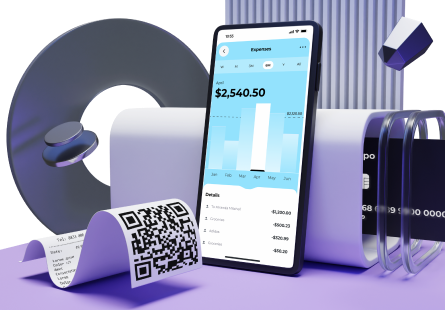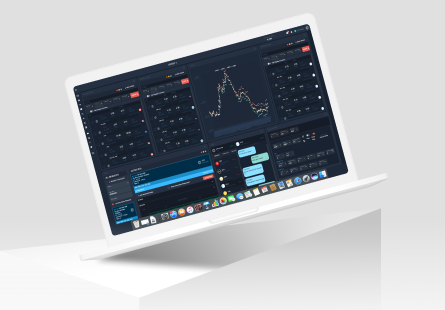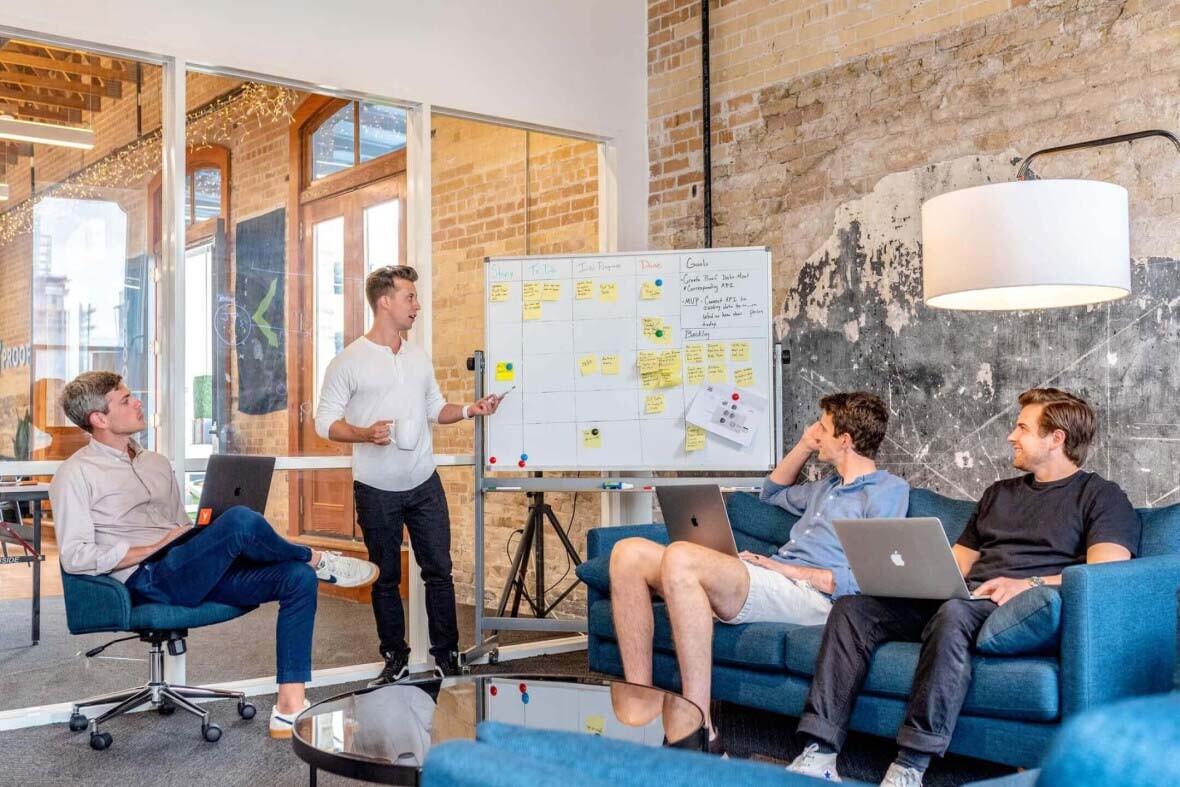With the incredible technological advancements happening here and there, things tend to be changing at a blistering pace in this modern world. So do business environments and customer needs, driving companies to reconsider their approach to managing processes. More so, failing to adapt to changes usually means lagging behind your competitors.
This is especially true when speaking about tech companies. To remain relevant and competitive, software development teams seek to roll out high-quality products in the shortest possible time frame, quickly responding to market changes and effectively interacting to reach their goals. This is reasonably achievable due to the Agile software development methodologies developed specifically for the fast software development, the DeepInsipre team being living proof. As devoted followers of the Agile model, we have a lot to share about Agile software development. Let’s get down to business.
Agile Model: a Brief Overview
Everything started back in 2001 when a group of software developers tired of documentation-driven and heavyweight software development processes created the Agile Manifesto. The Agile Manifesto does not explain any specific practices for Agile; it only establishes the core values and principles for Agile software development.
The Agile philosophy serves as a base for a set of approaches and management methods. Agile methods are based on iterative development: the tasks are broken into smaller iterations (sprints) with plans concerning the number, duration, and scope of each iteration clearly defined in advance. Each iteration typically lasts one to four weeks and involves a team working through a full software development lifecycle.
Agile Frameworks
An Agile framework is a specific approach to software development that is rooted in the Agile philosophy. Quite often, an Agile framework can be referred to as an Agile process or a methodology. However, most Agile teams utilize frameworks only as the basis for their Agile transformation, modifying them to cater to their unique needs.
Scrum, Adaptive Software Development (ASD), eXtreme Programming (XP), the Crystal Method, Scaled Agile Framework (SAFe), Rapid Application Development (RAD), Dynamic Systems Development Method (DDSM), and some others belong to the most popular Agile development frameworks.
Advantages of Agile Model
The Agile lifecycle model allows teams to deliver 80% of the product in 20% of the time, and that’s not all. Implementing the Agile methodology brings apparent advantages. Let’s take a closer look at them.
Enhanced product quality and greater customer satisfaction
Testing is an indispensable part of each sprint, which allows you to effectively track the quality and eliminate errors in the final product. In addition, Agile project management ensures that the customer is always in the loop about the project’s development through frequent meetings, helping to avoid misunderstandings. What is more, this approach is anchored in continuous feedback and collaboration that lets the developers spot and fix bugs faster and optimise the code throughout the development process, which inevitably results in high-quality software products.
More efficient risk management
Using the Agile model significantly reduces the risk that the software project will fail. An Agile software development team works in small sprints focusing on continuous delivery. During the sprints, developers systematically monitor the project’s progress and can identify any potential issues right away. Settling the issues before they escalate maximizes the project’s chance of success.
Improved communication
For Agile software development teams, face-to-face communication and non-stop interaction loom really large. Agile methods suggest having daily standups to ensure that everything goes smoothly and that each team member is working towards the same objectives. This helps mitigate potential confusion and succeed in achieving goals. While Agile methodology calls for regular feedback, communication with the client is no less essential. For instance, we have daily catch-up calls with our customers’ representatives and weekly status calls at DeepInspire.
Flexibility and process adaptability
Agile teams are highly responsive to changes, and they can quickly adapt their processes to meet the updated goals. This enables developers to deliver consistently and efficiently handle clients’ changing requirements.
More applicable metrics
In software development, metrics are critical for quality assurance, management, debugging, performance, and assessing costs. They can be used to spot, prioritize, track and communicate any issues to facilitate team productivity. Agile methods involve using a range of metrics that have proved more accurate and relevant if compared to those applied in traditional methodologies like the Waterfall model. They focus on achieving results and optimising performance, while the Waterfall model metrics express the project performance to the estimated cost and time ratio.
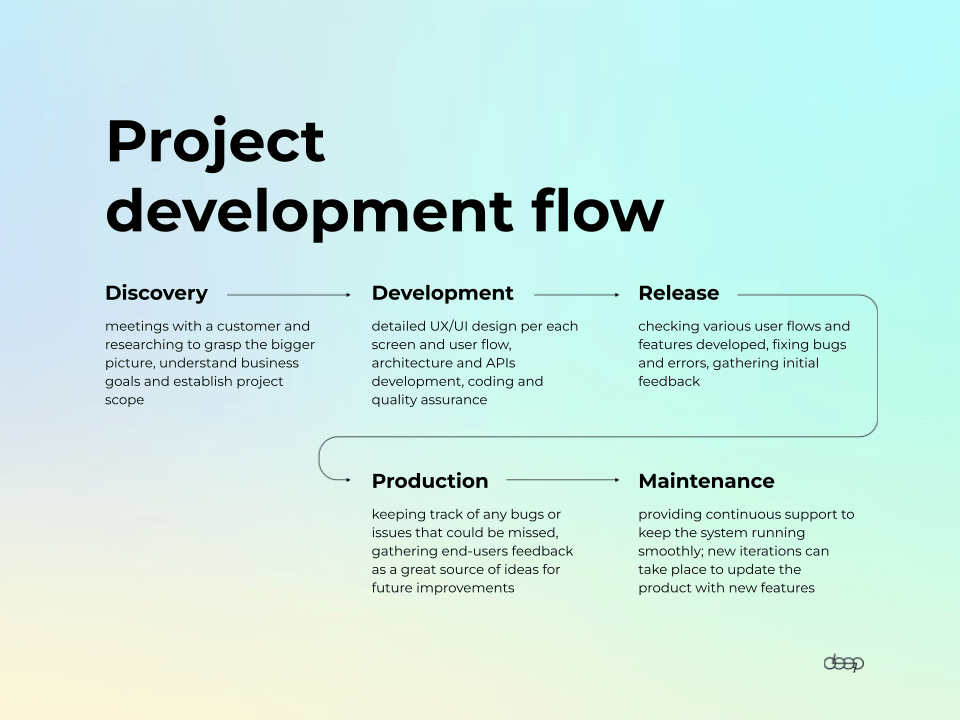
Agile SDLC Phases
Agile is realized throughout a sequence of stages known as the software development lifecycle. In DeepInspire the Agile project lifecycle entails the following phases:
Phase 1: Discovery
Discovery is the first phase of the Agile software development lifecycle that includes research, analysis, exploration, and planning. By analyzing documentation available, having meetings with all project stakeholders and conducting interviews with end-users, the Discovery Team gets a deep understanding of the clients’ business goals, needs, and pains.
The next step of Discovery includes the designer, product owner, project manager, business analyst, and stakeholders making a decision about what the product will look like. They also decide on the sequence of introducing functions and determine the development tools such as the programming language, syntax libraries, and frameworks. During design, Agile development teams often prototype the product’s UI (user interface) or even develop core functionality in a form of a “proof of concept” solution.
As a result of the Discovery phase following deliverables are created:
- defined the scope of the project and major requirements;
- estimated the time and cost of the project;
- defined UI/UX concept of the product, initial wireframes and user interface designs prepared;
- suggested technology stack and architecture outline, recommended features, suitable third-party solutions, security tips, etc;
- prepared initial key project documentation such as Project Charter and Product Backlog.
The discovery phase typically takes three weeks and four experts who are assigned to the dedicated team.
Phase 2: Concept
In this phase of the Agile software development cycle, the product owner (a team member responsible for maximizing the value of the products that an Agile software development team creates) determines the scope of the project and talks through the major requirements with the customer. It’s worth mentioning that the Agile method suggests keeping the requirements small since they can be added during the following stages. In the concept phase, the product owner also estimates the time and cost of the project.
Phase 3: Design
This step involves introducing the software development team to the requirements outlined during the previous phase. In the planning stage, the designer, product owner, project manager, business analyst, and stakeholders arrive at a decision about what the product will look like. They also decide on the sequence of introducing functions and determine the development tools such as the programming language, syntax libraries, and frameworks. During design, Agile development teams often prototype the product’s UI (user interface).
Phase 4: Development and coding
Next, the Agile software development life cycle enters the development phase, meaning that the team can start creating the first iteration of the software. The development phase covers UX/UI design, architecture, and coding. The product is delivered in sprints, each designed to enhance the current version of the software product.
Phase 5: Testing
To make sure that the software is fully functional, it’s crucial to conduct a series of tests before the product is released. During this phase of the Agile software development life cycle, testing specialists check if the code is clean, fix bugs and errors, and perform trial runs.
Phase 6: Production
Now, the software is entirely deployed and available to users. At this Agile software development life cycle phase, it’s imperative to keep track of any bugs or issues that could be missed during the testing phase.
Phase 7: Maintenance
This Agile software development phase takes place after the product has been released. The Agile approaches to software development suggest that the Agile team provides continuous support to keep the system running smoothly and tackle any issues. Additionally, new iterations can take place to update the product with new features.
Agile Workflow Process
The Agile lifecycle consists of iterations that typically last between two and four weeks. The workflow of Agile processes usually comprises the following five steps:
- identifying requirements
- product development
- software testing
- iteration delivery
- feedback
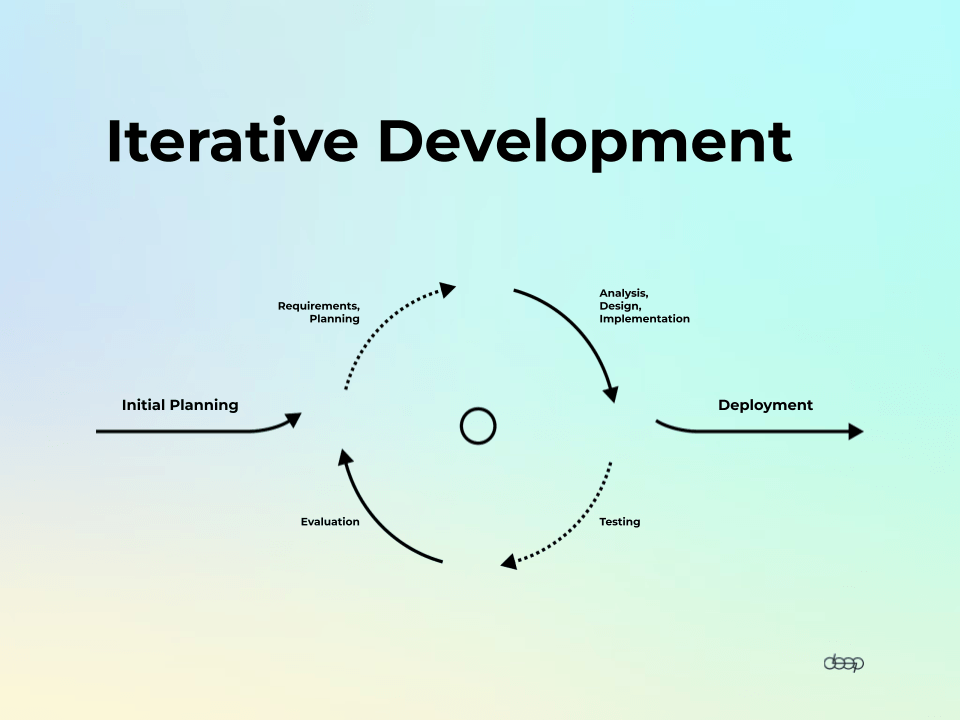
Each phase of the Agile development lifecycle can include numerous iterations since developers often need to go through all the processes several times to come up with perfectly working software and achieve the best possible quality of the product. Basically, these iterations are smaller cycles in the broader Agile lifecycle.
Final Thoughts
It’s safe to say that the Agile model is the best option for teams that strive to deliver valuable software to their customers in a shorter time. Agile software development methods help a software development team focus on the goals and needs of the customer and streamline organizational processes by implementing the iterative approach and actively using customer feedback. All in all, Agile practices are all about creating a comfortable environment for maximum value and customer satisfaction.
* * *
DeepInspire is a boutique software development company with deep fintech expertise and 24+ years of experience.
We provide outstanding software solutions by addressing both technology and business challenges. Whether you are a large enterprise, a midsize business, or a young startup, we are happy to help you dominate the turbulent and competitive market.
Feel free to check out our case studies or drop us a line to discuss your next project.
